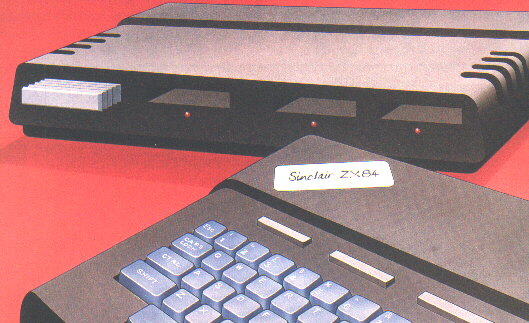SINCLAIR'S ZX84
Sinclair's latest computer does for the professional market just what the ZX80, ZX81 and Spectrum have done for the home micro market. When those early machines were released, they caused a furore in the computer industry by offering capabilities comparable with those of existing machines, but at vastly lower prices. This was usually achieved by packaging the components in a rather ingenious way - often replacing the conventional circuitry used in most micros with custom-designed ULAs. An uncommitted logic array is very expensive to design and put into production, but over a long production run using a ULA to take over the functions of conventional components makes the computer much cheaper as well as smaller and lighter. Sinclair's newest machine, the ZX83/ZX84 (the name depends on who you talk to within Sinclair Research) does all this and more. Until now, the packaging com-promises have made ZX computers rather unpleasant to use in some respects - the keyboards in particular have always come in for severe criticism from the computer press and end-users alike - and these limitations have always held the computers back from the more serious applications which their internal components could handle. The ZX84 may well be cheap - under £400 for the basic version - but its external attributes are far from nasty. And if you think that £400 is a lot of money to pay for a computer, then that's only because it is natural to assume that the ZX84 replaces the Spectrum in the same way that the Spectrum replaced the ZX80 and the ZX81 supplanted the ZX80. This is not the case. For the first time,
Sinclair is moving into what has hitherto been regarded
as the 'small business' market. The computer is far more
powerful than anything remotely near its price range,
leaving even relative newcomers like the IBM PC Jr (see
page 34) in the shade. One of the advantages of using a processor of the calibre of the 68000 is the enormous amount of memory which can be addressed directly. Eight-bit micros like the Newbrain and Elan which claim to be able to address megabytes of RAM do so only by paging it in and out, 64K at a time, with bank switching. On the most basic ZX84 you get 128K, twice as much as on the most capacious rivals, and this amount will be easily expandable. Anyone dealing with a
micro which has a minimum memory of 128K is likely to
find him - or herself playing around with much larger
files than would be necessary or even possible on a
Spectrum. This is when the cassette interface which has
served micro users for so long finally ceases to be a
viable proposition. At the moment, the lack of a built-in display prevents the ZX84 from being truly portable, but it would be an easy step to take with a later version. The prices of liquid crystal displays are falling sharply, and this type of display would be much more likely than the Sinclair flat screen, which does not really lend itself to computer applications. A big plus for some potential users (and a feature which is bound to become more widespread in the near future) is the option of an on-board modem similar to the internals of the Prism VTX 5000 unit which many Spectrum owners already use to log on to Prestel through Micronet 800. Our unofficial sources indicate that the Z80 processor which has been used in all ZX computers so far will not disappear from the new model. With two-processor computers now increasingly common, retaining the Z80 makes it easy to transport the Microdrive operating system to the new machine. The upward price limit for such a flexible system will be decided largely by the number of optional extras the user feels he needs, but with Sinclair Research girding its loins for an offensive on Acorn's position as manufacturer of the sole BBC approved computer, it is safe to assume that prices for roughly comparable BBC Micro and ZX84 systems (ignoring the Sinclair micro's superior processing capabilities) will tie up closely.. |
|
| [ Main Page ] [ Features ] |
